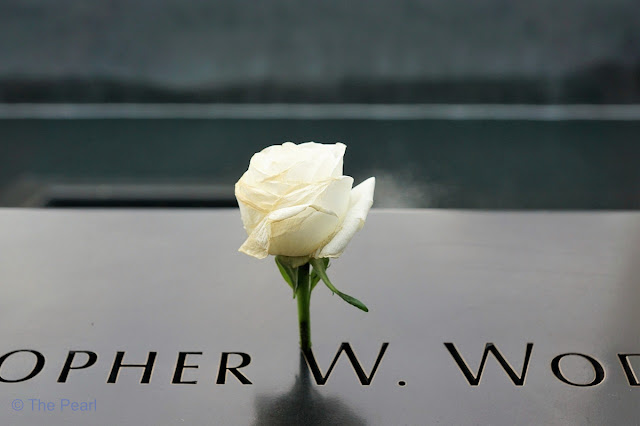“You may say that I'm a dreamer, but I'm not the only one. I hope someday you'll join us and the world will be as one.” ~John Lennon
The centerpiece of the 9/11 memorial plaza are the two pools sitting in the footprint of both the North and South Tower. Continuous running water flows from around the perimeter cascading down about 30 feet and creating the largest man-made waterfalls in America.
It was designed to be a public gathering place, open and spacious, to reflect the way the country and city came together after the attacks. The sound of running water drowns out the surrounding traffic and city sounds, giving the visitor a sense of calm.
In the middle of the pool is a secondary drop, where the water flows down an additional 30 feet. No matter where you stand, it’s impossible to see the bottom. You never know exactly where the water ends up. This reflects the feelings of emptiness when you lose someone you love. The empty space symbolizes both the loss of life and the physical void left by the destruction of the Twin Towers.
While the memorial and plaza are built to reflect on and remember 9/11, the Freedom Tower is meant to invoke the idea that our country and the city of New York cannot be defeated. Nicknamed “Freedom” after one of America’s founding ideals and great promises, the tower stands a total of 1,776 feet tall. This number was chosen specifically to celebrate the birth year of the United States of America.
The trees around the pools are white oak chosen from a 500-mile radius of where the three attacks occurred...the World Trade Center, Shanksville, PA and Washington D.C. The trees represent life and rebirth.
Around the pools, engraved in the parapets, are the names of the 2,977 victims of September 11, as well as the six victims of the 1993 bombing of the North Tower. The placement of each person’s name is based on their proximity at the time of the attacks and their relationship to adjacent names, such as coworkers or loved ones. That means almost every name is surrounded by people they cared about in some way.
Every morning before the memorial and museum opens, a volunteer places a white rose on the names of those who would have been celebrating a birthday. Two pictures are taken of the rose and name, one with the pool in the background and one with the skyline. The Birthday Rose photos are emailed to family members.
This is the 9/11 Memorial Museum. It sits between the two pools.
On 9/11 the entire World Trade Center, all seven buildings, were completely destroyed, along with the PATH train station that served millions of commuters traveling to Lower Manhattan. When rebuilding plans were discussed, one of the first major issues to tackle was building a new station. City planners wanted it to be a place that attracted residents and tourists alike.
The Oculus was designed by Spanish architect Santiago Calatrava. He designed it to resemble a dove leaving a child’s hands. The name comes from the strip of windows, or skylights, along the spine of the roof. Oculus is the Latin word for “eye,” which, in architecture, refers to a round or eye-like opening with a view of the sky. From the main hall you can see the Freedom Tower through these windows.
These windows also allow sunlight to pour in each morning. The angle of the windows is particularly placed so that every year on the anniversary of the attacks, the sun shines directly through the skylight and illuminates the main hall at 10:28 a.m. (the time of the collapse of the second tower). It’s called the “Way Of Light.” Calatrava positioned the building slightly tilted from the street grid in order to achieve the effect.

This night view of the Oculus was taken last year when I was in NYC.









No comments:
Post a Comment